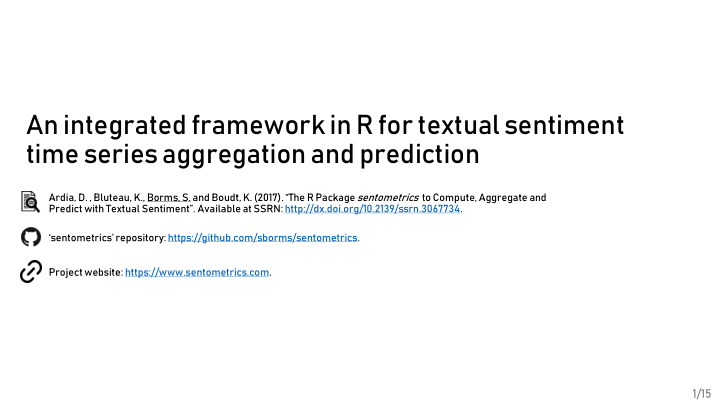



An integrated framework in R for textual sentiment time series aggregation and prediction Ardia, D. , Bluteau, K., Borms, S . and Boudt, K. (2017). “The R Package sentometrics to Compute, Aggregate and Predict with Textual Sentiment”. Available at SSRN: http://dx.doi.org/10.2139/ssrn.3067734. ‘sentometrics’ repository: https://github.com/sborms/sentometrics. Project website: https://www.sentometrics.com. 1/15
Text mining… … is the process of distilling actionable insights from text. Our focus is on textual sentiment analysis . 2/15
Time series econometrics… … is the analysis of quantitative time series data typically in an economic context. Our focus is on aggregation , econometric modelling and prediction . 3/15
econ ometrics sent iment analysis sentometrics research R package 4/15
Let’s go for a run with the R package ‘sentometrics’ We have a built-in dataset of news articles between 1995 and 2014, from The Wall Street Journal and The Washington Post. ID DATE TEXT WSJ WAPO ECONOMY NONECONOMY 1 1995-01-02 Full text 1 1 0 1 0 2 1995-01-05 Full text 2 0 1 1 0 … … … … … … … Features : relevance/importance indicators & selectors. Step 1 5/15
Massaging the corpus Checking the requirements of the corpus. Subsetting the corpus, using the quanteda package. Adding features (for example: entities, topics, events). Step 1 6/15
Pick the word lists for lexicon-based sentiment analysis We have English, Dutch and French built-in word lists. Prepare and check the lexicons. Steps 2 – 3 7/15
From sentiment to time series: aggregation specs Aggregation of the many sentiment scores… … within documents = document-level sentiment … across documents = time series 1 time series … across time = smoothed time series … across lexicons , features and time aggregation schemes P time series One control function to define all of this. Steps 2 – 3 8/15
Ready to create some sentiment time series This one simple function call gives you a wide number of different sentiment time series, or “measures”. The sentiment measures are represented as “lexicon— feature —smoothing”. feature lexicon time aggregation scheme Steps 2 – 3 9/15
Plotting across the three time series dimensions Steps 2 – 3 10/15
We try to predict the monthly U.S. EPU index… The Economic Policy Uncertainty (EPU) index is a partly news-based measure of policy-related economic uncertainty. It is served with the package as a dataset. http://www.policyuncertainty.com Steps 4 – 5 11/15
… using elastic net regularization We propose to use the elastic net regression (relying on glmnet ),which balances between the LASSO and Ridge regressions through an 𝛽 parameter. The large number and collinearity of the sentiment measures motivate this choice. target other explanatory sentiment variables A straightforward control function defines the model setup. Steps 4 – 5 12/15
Ready to run the prediction model iteratively Load the data. Running the out-of-sample prediction analysis is easy. We call “attribution” the decomposition of the prediction into one of the underlying sentiment time series dimensions. Steps 4 – 5 13/15
Visualizing the out-of-sample prediction and attribution Steps 4 – 5 14/15
Next steps The package already offers quite some flexibility to develop sentiment time series. Improvements along: Faster and more complex sentiment analysis; Interfaces to more types of models; More flexible aggregation and modelling. Purpose? Become the go-to package for embedding textual sentiment into the prediction of other variables! If you want to help out, get in touch! 15/15
Recommend
More recommend